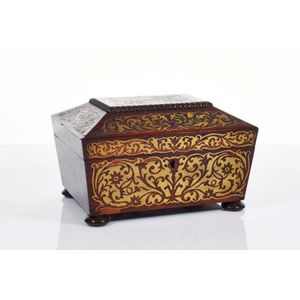19th Century French Oak Apostle Chest
You must be a subscriber, and be logged in to view price and dealer details.
Subscribe Now to view actual auction price for this item
When you subscribe, you have the option of setting the currency in which to display prices to $Au, $US, $NZ or Stg.
- Pilasters - In furniture a pilaster is a flattened column-like detail
applied to furniture. It is similar to a pilaster in architecture, but it is
typically smaller and less ornate. Pilasters are often used to decorate the
fronts of bookcases, cabinets, and other pieces of furniture. Pilasters can be
made of wood, metal, or other materials. They can be fluted, carved, or plain.
Pilasters are often used to add a touch of elegance and sophistication to
furniture. - Foliate - Decorated with leaves or leaf-like forms.
- Bun Feet - Similar to ball feet, though somewhat compressed or flattened in appearance. Introduced during the late 17th century, but they have been used on furniture up to the present day.
- Oak - Native to Europe and England, oak has been used for joinery, furniture and building since the beginning of the medieval civilisation. It is a pale yellow in colour when freshly cut and darkens with age to a mid brown colour.
Oak as a furniture timber was superceded by walnut in the 17th century, and in the 18th century by mahogany,
Semi-fossilised bog oak is black in colour, and is found in peat bogs where the trees have fallen and been preserved from decay by the bog. It is used for jewellery and small carved trinkets.
Pollard oak is taken from an oak that has been regularly pollarded, that is the upper branches have been removed at the top of the trunk, result that new branches would appear, and over time the top would become ball-like. . When harvested and sawn, the timber displays a continuous surface of knotty circles. The timber was scarce and expensive and was used in more expensive pieces of furniture in the Regency and Victorian periods.
This item has been included into following indexes:
- coffers - European 178
- oak - trunks 321
Visually similar items

Antique 18th century French carved oak coffer, fitted with carved panels to the front, alterations and restorations, 109 cm long, 73 cm high

A Georgian oak mule chest, with two drawers in base and internal candle tray with two small drawers, ornately carved decoration, arched panels of floral designs and traditional motifs, brass bale handles and ogee bracket feet. 140 cm x 55 cm x 87 cm

Regency rosewood sewing casket, of sarcophagus shape, with brass overlay, on four ball feet. Height 16.5 cm. Width 27 cm. Depth 20 cm

A Regency penwork tea caddy, English, crica 1810, 18 cm high, 22 cm wide, 14.5 cm deep
